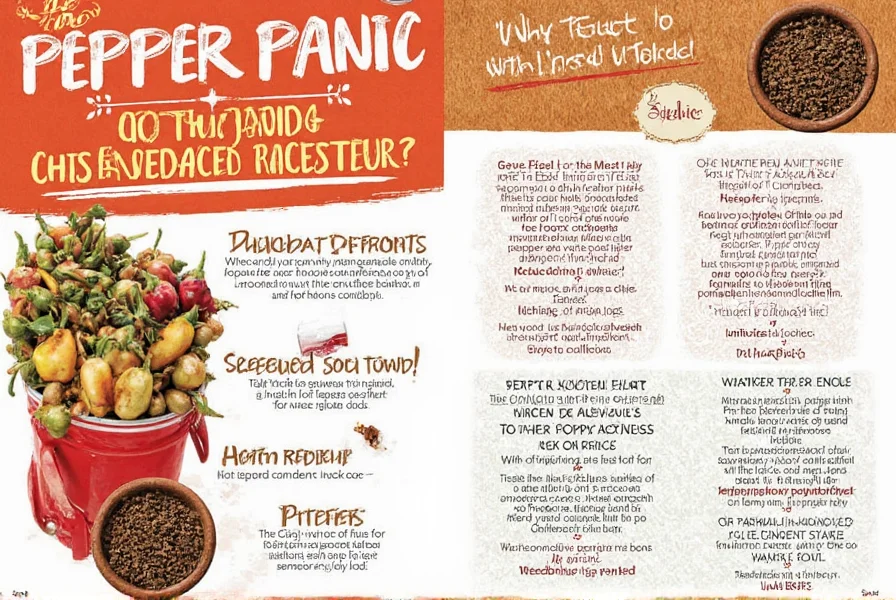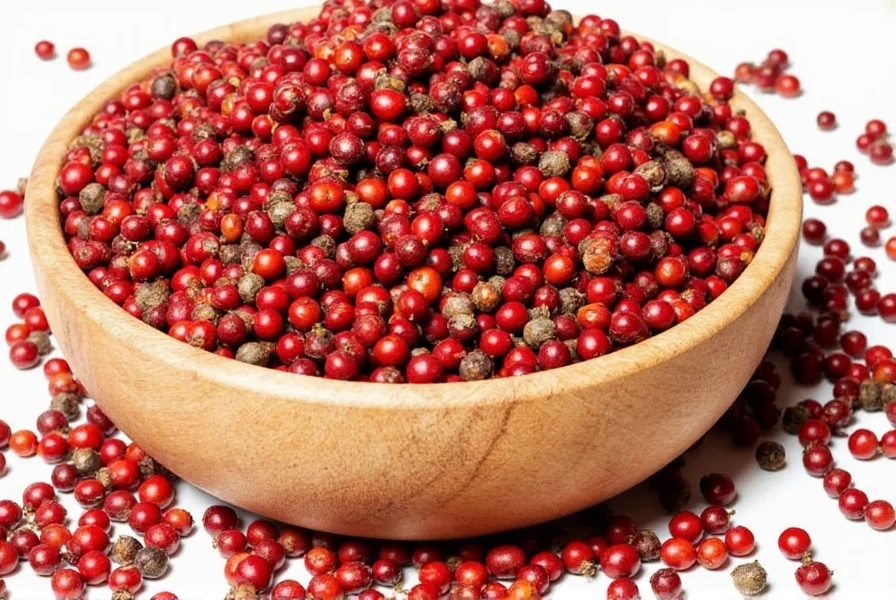There are five main types of peppercorns: black, white, green, red, and pink. Each type is processed differently, resulting in unique flavors and culinary uses. Black pepper is the most common, with a bold, earthy taste; white pepper is milder and used in light-colored dishes; green peppercorns are fresh and herbal; red peppercorns are sweet and fruity; and pink peppercorns (not true peppercorns) are berry-like and used as garnishes.
| Type | Origin | Flavor Profile | Best Uses |
|---|---|---|---|
| Black Pepper | India | Earthy, sharp, bold | All-purpose seasoning, sauces, rubs |
| White Pepper | Indonesia/Vietnam | Milder, earthy, musty | Creamy sauces, mashed potatoes, soups |
| Green Pepper | France/Vietnam | Fresh, herbal, slightly tart | Vietnamese dishes, pickling, Thai food |
| Red Pepper | India/Sri Lanka | Fruity, sweet, floral | Exotic dishes, desserts, gourmet recipes |
| Pink Pepper | Peru/Brazil | Berry-like, sweet, citrusy | Garnishes, salads, cocktails |
What Is a Peppercorn?
The humble peppercorn comes from the Piper nigrum plant, a flowering vine native to India's Malabar Coast. These tiny berries (yes, they are technically fruits!) have been prized for centuries as both a seasoning and a currency. Ancient Roman armies were paid in pepper, and European explorers sailed oceans just to find new sources of it.
How to Use Different Peppercorns in Cooking
Now that you know what each peppercorn tastes like, let's get cooking! Here's a quick guide to putting them to use in your kitchen:
Black Pepper
- Add freshly ground black pepper to scrambled eggs, steak, pasta, or roasted vegetables.
- Use cracked black pepper in marinades and dry rubs.
- Make homemade pepper sauce using crushed black peppercorns simmered with cream and butter.
White Pepper
- Ideal for light-colored dishes like béchamel, risotto, or poached fish.
- Great for Asian broths and soups — especially in Chinese hot pot seasonings.
- Try in mashed potatoes for a subtle warmth that doesn't visually disrupt the dish.
Green Pepper
- Use brined green peppercorns in French-inspired dishes like coq au vin or boeuf en daube.
- Add freeze-dried green peppercorns to curry pastes or spice blends for freshness.
- They pair well with seafood — try in a coconut-based shrimp curry!
Red Pepper
- Infuse red peppercorns in syrups or reductions for desserts.
- Combine with honey and balsamic vinegar for a glaze over roasted duck.
- Add a few whole red peppercorns to a jar of pickles for extra flair and flavor.
Pink Pepper
- Crush and sprinkle over salads, cheeses, or fruit platters for color and zing.
- Perfect in cocktails — muddle a few in a Bloody Mary or margarita.
- Use in dessert rubs — think chocolate or fig-based treats with a hint of berry-like heat.

Buying Guide: Choosing the Right Peppercorns for Your Kitchen
With so many options out there, choosing the right peppercorns can feel overwhelming. But don't worry — here's a handy buying guide to help you make the best choices for your pantry.
1. Whole vs. Ground
Whole peppercorns last longer and retain more flavor than pre-ground pepper. Invest in a good pepper mill to keep your spices fresh and fragrant.
- Whole peppercorns: Ideal for long-term storage and controlled grinding.
- Pre-ground pepper: Convenient but loses potency quickly.
2. Organic vs. Conventional
Organic peppercorns are grown without synthetic pesticides or fertilizers. They may cost more, but if purity matters to you, it's worth considering.
- Organic peppercorns: Better for health-conscious cooks and sustainability.
- Conventional peppercorns: More affordable, but may contain traces of agricultural chemicals.
3. Brand Comparison
Here are some top-rated brands to consider:
| Brand | Type | Features | Best For |
|---|---|---|---|
| The Spice Garden | Whole Black Peppercorns | Organic, fair trade, sustainably sourced | Daily cooking and grinding |
| Penzeys Spices | Multi-Pepper Blend | Premium quality, curated mix of black, green, pink | Chefs and home cooks who love variety |
| Mrs. Dash | Ground Black Pepper | Low sodium alternative | Health-focused diets |
| Berkeley Farms | White Peppercorns | Mild, creamy finish | Light-colored sauces and soups |
4. When to Splurge and When to Save
- Splurge on: Whole peppercorns (especially rare varieties like red or pink) and organic brands.
- Save on: Pre-ground black pepper for daily use — but remember it fades fast.
Storage Tips for Freshness and Flavor
Proper storage ensures your peppercorns stay flavorful and aromatic for months — even years!
- Air-tight containers: Store whole peppercorns in glass jars or metal tins away from light and moisture.
- Keep them cool: Heat speeds up degradation. Keep them in a cupboard or pantry, not near the oven.
- Don't refrigerate: Humidity ruins peppercorns. Only store in fridge if in a very humid environment and tightly sealed.
- Grind as needed: Grind only what you need for a meal. Once exposed to air, flavor starts to fade.

Frequently Asked Questions About Peppercorns
What's the main difference between black, white, green, and red peppercorns?
The main difference lies in when the peppercorns are harvested and how they're processed. Black peppercorns are unripe berries sun-dried until wrinkled. White peppercorns come from ripe berries with the outer layer removed. Green peppercorns are harvested while still immature and preserved through brining or freeze-drying. Red peppercorns are fully ripe berries that are either sun-dried or preserved in brine. Pink peppercorns aren't true peppercorns at all but come from a different plant (Schinus terebinthifolius).
Which peppercorn is the hottest?
Black peppercorns are generally considered the hottest due to their high piperine content. White pepper is milder but can have a sharper heat, green pepper is fresher and more herbal with moderate heat, red pepper is sweet and floral with minimal heat, and pink pepper has very little heat with a berry-like flavor.
Can I substitute one type of peppercorn for another in recipes?
Yes, but with some considerations. Black pepper can generally substitute for white pepper, but not vice versa in light-colored dishes where appearance matters. Green peppercorns can be substituted with black pepper in a 1:1 ratio but will change the flavor profile. Pink peppercorns shouldn't be substituted for true peppercorns as they have a completely different flavor. For best results, use the specific peppercorn called for in recipes that specify a particular type.
Why do chefs prefer freshly ground pepper over pre-ground?
Freshly ground pepper retains more of its essential oils and volatile compounds that give pepper its distinctive flavor and aroma. Pre-ground pepper loses these compounds quickly when exposed to air, resulting in diminished flavor. Whole peppercorns can stay fresh for 3-5 years when stored properly, while pre-ground pepper begins losing potency within weeks.
Are pink peppercorns safe to eat?
Yes, pink peppercorns are safe to eat for most people when consumed in culinary amounts. They come from the Peruvian peppertree (Schinus molle) or Brazilian pepper tree (Schinus terebinthifolius). However, some individuals with nut allergies may experience reactions as they're related to cashews and pistachios. They should be used as a finishing spice rather than cooked extensively, as high heat can cause them to become bitter.
What's the best peppercorn for steak?
Black peppercorns are traditionally the best choice for steak. Their bold, earthy flavor complements the richness of beef perfectly. Coarsely cracked black pepper creates a flavorful crust when seared. Some chefs also recommend mixing in a small amount of pink peppercorns for added complexity, but black pepper remains the classic choice for steak seasoning.
How can I tell if my peppercorns have gone bad?
Fresh peppercorns should have a strong, distinctive aroma when crushed. If they've lost their scent or taste bland when ground, they've likely gone stale. Whole peppercorns rarely spoil but do lose potency over time. Signs they've gone bad include mold (if improperly stored in humid conditions), an off smell, or visible deterioration. Properly stored whole peppercorns maintain flavor for 3-5 years.
Final Thoughts on Peppercorn Diversity
Who knew such tiny berries could carry so much history, flavor, and versatility? Understanding the differences between black, white, green, red, and pink peppercorns opens the door to culinary creativity and sophistication.
Whether you're spicing up a weeknight stir-fry or impressing guests with a pink peppercorn-infused cocktail, each type has its moment to shine. So next time you reach for that shaker, pause — and ask yourself: which peppercorn deserves the spotlight today?
| Type | Origin | Heat Level | Shelf Life | Best Used In |
|---|---|---|---|---|
| Black Pepper | India | Medium-High | 3–5 years | Most savory dishes |
| White Pepper | Indonesia/Vietnam | Medium | 2–4 years | White sauces, soups |
| Green Pepper | France/Vietnam | Low-Medium | 1–2 years | French and Southeast Asian dishes |
| Red Pepper | India/Sri Lanka | Low | 1 year | Exotic dishes, desserts |
| Pink Pepper | Peru/Brazil | Very Low | 6–12 months | Cocktails, garnishes, salads |










 浙公网安备
33010002000092号
浙公网安备
33010002000092号 浙B2-20120091-4
浙B2-20120091-4